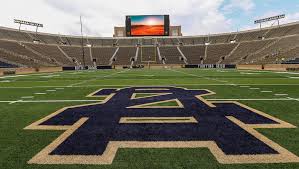Under the lights of South Bend, Notre Dame will host USC on October 18th in what could be the final chapter of college football’s most storied intersectional rivalry played on Indiana soil. The PrimeTime showdown is already one of the most anticipated games on the 2025 calendar, but it now carries an emotional weight and historical significance that stretches far beyond the field. After nearly a century of annual battles filled with legends, upsets, and unforgettable moments, everything behind the scenes points to this being the penultimate meeting in a series that has defined generations of college football greatness. If what sources indicate proves true, Southern Cal is preparing to end its commitment to the annual Notre Dame game after the 2026 installment in Los Angeles.
The rivalry between Notre Dame and USC—often referred to as “The Greatest Intersectional Rivalry” in college football—has been contested 96 times since it began in 1926. This isn’t just another high-profile matchup; it’s a clash of cultural, regional, and philosophical football ideologies. From Knute Rockne to Lou Holtz, from Marcus Allen to Reggie Bush, the matchup has showcased Heisman winners, national champions, and unforgettable finishes. It’s one of the last remaining annual rivalries that bridges two completely different parts of the country: Midwest grit vs. West Coast flair. But now, modern college football’s shifting priorities and geographic realignments are threatening to fracture the foundational traditions that once felt untouchable.
Since USC’s move to the Big Ten Conference became official last year, the program’s approach to scheduling has reportedly changed. As a now full-fledged Big Ten member, the California-based university believes it no longer needs to travel to the Midwest for a non-conference game. That position complicates the long-standing home-and-home series with Notre Dame, which has historically alternated between South Bend and Los Angeles. According to sources with direct knowledge of internal discussions at USC, the school is seriously considering ending the Notre Dame rivalry after the 2026 game at the Coliseum.
That would mean this year’s October 18th clash could be the final time Notre Dame hosts USC in South Bend. For fans of both programs, and for lovers of college football history, that’s a sobering thought. Rivalries like this don’t just create memorable Saturdays—they shape identities, fuel traditions, and connect generations of alumni and supporters. Losing a series of this magnitude would be a seismic cultural blow to the sport at large, not just the two schools involved.
It’s also worth noting that the rivalry has endured through nearly every major challenge thrown at it—wars, coaching changes, conference shakeups, and even a global pandemic. But this time, the changing landscape of college football’s power structure may prove too great an obstacle. In the new Big Ten, where USC now shares a conference with traditional Midwest powers like Ohio State, Michigan, and Penn State, the argument within Trojan leadership is that the cross-country travel demands of a Notre Dame game are no longer worth it. Especially when the conference already sends them east multiple times per season.
To be clear, nothing has been officially announced, and there’s always room for negotiation when television ratings and brand power are in play. Notre Dame, as an independent powerhouse with its own national media deals and a global fanbase, certainly has the leverage and incentive to keep the rivalry alive. The Irish have long viewed the annual USC game as an essential part of their schedule, a measuring stick, and a statement of national relevance. But if USC chooses to exercise its opt-out after the 2026 matchup, the reality is Notre Dame would be left looking to fill one of the most significant gaps in its historic calendar.
This wouldn’t be the first iconic rivalry to fall victim to realignment and modern-day scheduling complications. Texas and Texas A\&M paused their annual series for more than a decade after the Aggies joined the SEC. Nebraska and Oklahoma, once the defining rivalry of the Big Eight and early Big 12 era, now only meet on rare occasions. The pressures of conference obligations, playoff expansion, and media rights deals have pushed many traditional rivalries to the brink of extinction. Notre Dame vs. USC may simply be the latest casualty.
What makes this potential ending especially poignant is how much the rivalry has meant to each program over the years. The game has almost always carried national implications—more than 30 times, at least one team was ranked in the top 10 heading into the matchup. Legendary coaches like Ara Parseghian, John McKay, Lou Holtz, and Pete Carroll made their names in this series. Iconic games—like Notre Dame’s “Green Jersey Game” in 1977, or the infamous “Bush Push” in 2005—have left indelible marks on the memory of college football fans.
For many players, beating the Trojans or Irish is a career-defining moment. For many coaches, it’s the difference between being remembered fondly or shown the door. And for the fanbases, this isn’t just a game—it’s a war of pride, coast versus coast, tradition versus innovation.
If the end is truly near, this year’s PrimeTime matchup in South Bend will carry a sense of finality. It will be more than just a football game—it will be a tribute to one of the greatest rivalries in American sports. The Notre Dame faithful will undoubtedly pack Notre Dame Stadium with the kind of energy and passion typically reserved for title games. They’ll understand what’s at stake, emotionally if not mathematically. And USC, despite its internal conversations, will likely approach the game with that same sense of reverence and intensity.
The question, then, is not just about whether USC should continue playing Notre Dame. It’s about whether the soul of college football can survive in a world where decisions are increasingly made in boardrooms and spreadsheet columns rather than in locker rooms and trophy rooms. There’s something sacred about traditions that span generations. They remind fans why they fell in love with the game in the first place. They remind schools of their unique place in the broader story of college athletics. Losing a rivalry like USC vs. Notre Dame isn’t just erasing a date on a calendar—it’s erasing a legacy.
To walk away from that is to walk away from nearly a century of shared history. From the handshake agreement in the 1920s that birthed the series, to the emotional tributes after 9/11 and the deep respect shown even in defeat, this rivalry has always been about more than wins and losses. It’s been about representing the best of college football’s ideals—loyalty, competition, sportsmanship, and excellence.
Yet if USC follows through with the plan to exit after 2026, it will mark the end of an era. The 97th meeting would then become the finale of a nearly unbroken stretch of annual games that have defined fall Saturdays for so many. And while Notre Dame will undoubtedly find another marquee opponent, and while USC will continue to chart its course in the evolving Big Ten landscape, something irreplaceable will be lost.
Until then, October 18th looms large. South Bend will serve as the emotional epicenter of college football that night. The echoes of past games will be felt in every tackle, every touchdown, and every note of the fight songs that fill the air. Fans will hold on to every moment, just in case it’s the last time they see those golden helmets lined up opposite those cardinal and gold jerseys in Indiana. And should the curtain truly close on the greatest intersectional rivalry in college football, at least it will go out in a blaze of PrimeTime glory—under the lights, with everything on the line, just the way it should.



